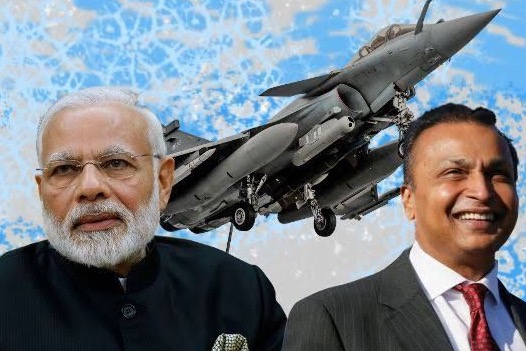As India recently received Rafale Jets from France in view of its agreement of 2016 which was negotiated between former French President Francois Hollande, and Prime Minister Narendra Modi.

The agreement was signed for the purchase of 36 Rafale combat aircraft at a value of € 7.87 billion or about 60,000 crores. The procurement of Dassault Aviation Rafale fighter jets from France supports the ‘Make in India’ initiative. This simply means that the French side will now facilitate the implementation of ‘Make in India’.
The procurement of Rafale jets has laid the foundation of numerous controversies of which one encircles the business tycoon, Anil Ambani.

Recently, Anil Ambani’s several group companies have been declared bankrupt and numerous of his assets have been taken over by banks. The latest one is the Yes Bank’s takeover of Anil Ambani’s Reliance Group headquarters at Santacruz and two other offices in South Mumbai over the recovery of Rs. 2892 crore loan to Reliance Infrastructure.
Several opposition leaders and critics has raised the question about the joint-venture of Dassault Aviation with Ambani’s Reliance Group. These criticisms are on the point that merely two weeks after the signing of the agreement between India and France in 2016, Dassault and Reliance announced their joint-venture Dassault Reliance Aerospace Limited (DRAL). It was reported in 2019 that Dassault Aviation is likely to start manufacturing components of the Rafale fighter jets at the Nagpur facility of DRAL with the wares destined for global customers.
Anil Ambani firm has also a history of incomplete projects. The one came into light when Maharashtra government initiated to take back the development projects of Latur, Osmanabad, Nanded, Yavatmal and Baramati airports from the Reliance Airport Development which contracted to them in August 2009. Another event which took the limelight was when Reliance Sea Link One, a consortium of Reliance Infrastructure and Hyundai Engineering bagged the Rs 5000 crore Worli-Haji Ali project in 2010 that also went in the dust.
Netizens are also raising questions that despite having no experience in aircraft production, why Ambani’s sinking company was given the contract instead of Hindustan Aeronautics Limited. It was alleged that the deal was made because of Ambani’s closeness to the top government officials. The opposition leaders also alleged the deal as ”promoted corruption”.
Despite being boasted by Indian media at a great scale, there are also people who are criticizing this deal on many solid grounds by raising baffling questions.

Military experts have not only demeaned the capabilities of Rafale Jets against US aircraft but they also raised questions why the Rafale Jets failed to compete in the international arms markets and got dumped by a number of nations. Their arguments and questions are something mind-boggling which led us to think about the Rafale enigma.
As a whole, Rafale was not the only choice we have, apart from Dassault’s Rafale, we have, Lockheed Martin’s F-16s, Boeing’s F/A-18s, Eurofighter Typhoon, Russia’s MiG-35, Sweden’s Saab’s Gripen as the bidders for the contract of 126 fighter jets. Of which, the Eurofighter Typhoon and Dassault Rafale were shortlisted. Dassault received the contract of 126 jets on the basis that it was the lowest bidder and the aircraft was said to be easy to maintain. Although the initial plan was to buy 126 jets but India scaled it down to 36, that too in fly-away condition.
It was reported by EurAsian Times, that Russian aviation experts had claimed that Rafale jets would have been useless against the Chinese Airforce (PLAAF). The main setback is that the speed of the Rafale jets is about Mach 1.8 while that of Chinese J-16s is Mach 2.2. The practical ceiling of Rafale jets is also lower than the J-16s and even the engine thrust of the Chinese J-16s is far superior than that of the French aircraft. Even if the Indian Air Force (IAF) was to deploy all 36 of its newly acquired jets, the technical superiority would still be on the side of China, claimed the Russian expert.
The Rafale being the most expensive aircraft in the international market costs India 60,000 crore for the deal of 36 jets. Experts argue that the high cost is the outcome of many reasons including the general inefficiency of the country’s defence sector, along with the small scale on which the Rafale is being produced in comparison to rival fighters such as the F-18, MiG-29 or F-35 due to which Rafale has not benefitted from economies of scale. This has contributed to its poor performance in the international markets.
“Indian media is celebrating the arrival of five Rafales as if they won a war against China. If Rafale is so good, why Oman, Korea, Singapore, Libya, Kuwait, Canada, Brazil, Belgium, UAE, Switzerland, Malaysia refused to buy it. Besides India, only Qatar & Egypt have bought it,” tweeted Ashok Swain, Professor of Peace and Conflict Research, UNESCO Chair of International Water Cooperation.
Other than France and India, only Qatar and Egypt are using Rafale jets and that too in very limited numbers. India being the third buyer of the Dassault’s Rafale Jets.
According to Snehesh Alex Philip’s opinion piece in ThePrint, beneath the celebration of the arrival of Rafale jets, lies the harsh reality of India’s painfully slow defence purchases. The Rafale deal and a plethora of procurement, now being done under the emergency clause in the wake of tensions at the Line of Actual Control (LAC), exposes the malaise that continues to shadow India’s defence procurement and planning. “Merely having a large standing Army or an Air Force with aircraft flying on an extended lease of life and without much use against modern weaponry of the enemy, cannot be India’s answer,” he wrote.
[zombify_post]










I love how this guy’s analysis is just 100% useless one year later, when rafale is being exported like crazy. I guess he’s not so knowledgeable after all.